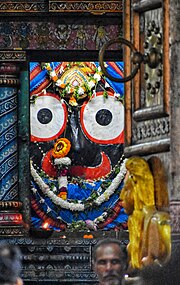
Back ওড়িশি সঙ্গীত Bengali/Bangla Musique Odissi French ଓଡ଼ିଶୀ ସଙ୍ଗୀତ OR ਓਡੀਸੀ ਸੰਗੀਤ Punjabi ஒடிய இசை Tamil
| Oṛiśī Sangīta |
| Odissi music |
|---|
 |
| Composers |
| Shāstras |
| Compositions |
| Instruments |
| Indian classical music |
|---|
 |
| Concepts |
Odissi music (Odia: ଓଡ଼ିଶୀ ସଙ୍ଗୀତ, romanized: oṛiśī sangīta, Odia: [oɽisi sɔŋgit̪ɔ] ) is a genre of classical music originating from the eastern state of Odisha. It is played on traditional instruments like the mardala, veena, and bansuri. Rooted in the ancient ritual music tradition dedicated to Lord Jagannatha, Odissi music has a rich history spanning over two thousand years, distinguished by its unique sangita-shastras (musical treatises), a specialized system of Ragas and Talas, and a distinctive style of performance. While some Indian classical music like Carnatic music and Hindustani music, traditions evolved separately over centuries, Odissi music has retained its classical purity and its characteristic devotion-centered compositions. Odissi compositions are largely written in Sanskrit and Odia.[1][2][3]
The various aspects of Odissi music include Odissi prabandha, Chaupadi, Chhanda, Champu, chautisā, janāna, Mālasri, Bhajana, Sarimāna, Jhulā, Kuduka, Koili, Poi, Boli, and more. Presentation dynamics are roughly classified into four: raganga, bhabanga, natyanga and dhrubapadanga. Some great composer-poets of the Odissi tradition are the 12th-century poet Jayadeva, Balarama Dasa, Atibadi Jagannatha Dasa, Dinakrusna Dasa, Kabi Samrata Upendra Bhanja, Banamali Dasa, Kabisurjya Baladeba Ratha, Abhimanyu Samanta Singhara and Kabikalahansa Gopalakrusna Pattanayaka.[4]
According to Bharata Muni's Natya Shastra, Indian classical music has four significant branches: Avanti, Panchali, Odramagadhi and Dakshinatya. Of these, Odramagadhi exists in the form of Odissi music. Odissi music crystallised as an independent style during the time of the early medieval Odia poet Jayadeva, who composed lyrics meant to be sung, set to ragas and talas unique to the local tradition.[5] However, Odissi songs were written even before the Odia language developed. Odissi music has a rich legacy dating back to the 2nd century BCE, when king Kharavela, the ruler of Odisha (Kalinga), patronized this music and dance.[6]
The traditional artforms of Odisha such as Mahari, Gotipua, Prahallada Nataka, Radha Prema Lila, Pala, Dasakathia, Bharata Lila, Khanjani Bhajana, etc. are all based on Odissi music. Odissi is one of the classical dances of India from the state of Odisha; it is performed with Odissi music.[7]
- ^ Cite error: The named reference
:0was invoked but never defined (see the help page). - ^ Parhi, Kirtan Narayan (2017). The Classicality of Orissi Music. India: Maxcurious Publications Pvt. Ltd. p. 383. ISBN 978-81-932151-2-8.
- ^ Ho, Meilu (2013-05-01). "Connecting Histories: Liturgical Songs as Classical Compositions in Hindustānī Music". Ethnomusicology. 57 (2): 207–235. doi:10.5406/ethnomusicology.57.2.0207. ISSN 0014-1836.
- ^ Patnaik, Kabichandra Kali Charan. A Glimpse into Orissan Music. Bhubaneswar, Odisha: Government of Orissa. p. 2.
- ^ Tripathī, Kunjabihari (1963). The Evolution of Oriya Language and Script. Utkal University. p. 22. Archived from the original on 3 July 2023. Retrieved 17 December 2022.
- ^ Mohanty, Gopinath (August 2007). "Odissi - The Classic Music" (PDF). Orissa Review. Culture Department, Government of Odisha. Archived from the original (PDF) on April 10, 2009. Retrieved February 7, 2010.
- ^ Rath, Shantanu Kumar. Mishra (ed.). "Odia Lokanatakaku Ganjamara Abadana" ଓଡ଼ିଆ ଲୋକନାଟକକୁ ଗଞ୍ଜାମର ଅବଦାନ [Role of Ganjam in Odisha's performing art traditions]. Rangabhumi (in Odia). 9. Bhubaneswar: Odisha Sangeet Natak Akademi, Department of Culture, Government of Odisha: 52–64.